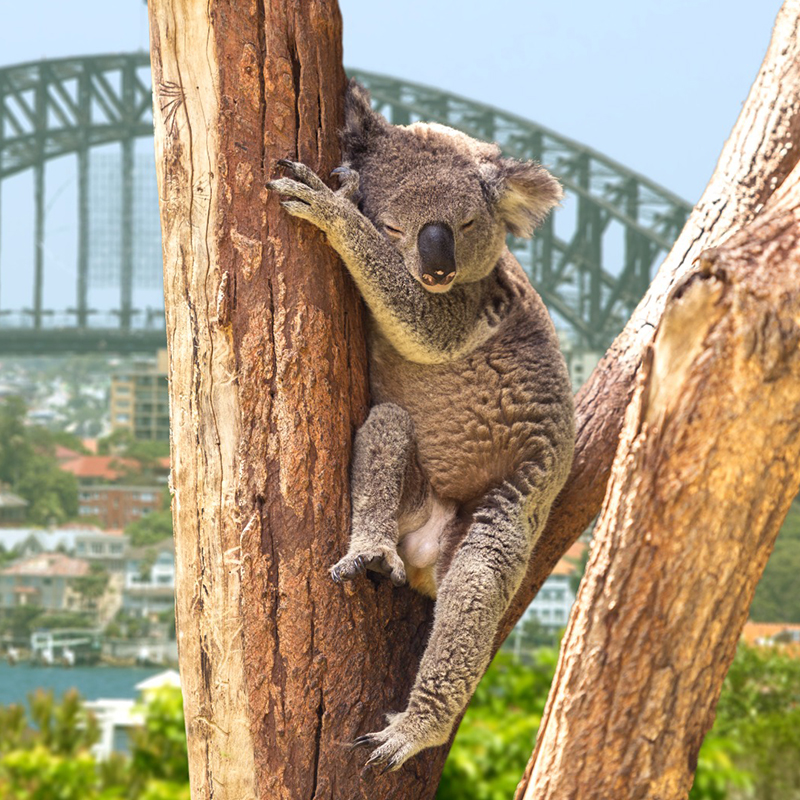Australia’s Treasured Fauna – Marsupials
Australia’s symbolic mammal, the kangaroo, represents the country. Its long tails, strong hind legs, and unique hopping stride set it apart. These herbivorous animals feed on grasses, leaves, and shrubs. Australia is home to kangaroos in various settings, including woods and grasslands. Their adaptation to the continent’s dry climate is impressive, and some species—like the red kangaroos—can even store water by slowing down their metabolic rate.
- Habitat: Kangaroos are found across various habitats in Australia, from grasslands to forests.
- Notable Features: These iconic marsupials are known for their powerful hind legs and distinctive pouches.
- Diet: Kangaroos are herbivores, primarily feeding on grasses, leaves, and shrubs.
Koalas, native to Australia, are iconic marsupials known for their adorable appearance and leisurely lifestyle. Their fluffy ears and distinctive nose easily capture people’s hearts worldwide. Koalas spend most of their time lounging in the branches of eucalyptus trees, where they sleep up to 18 hours daily. Despite their sleepy demeanour, they are skilled climbers and can move swiftly when necessary. Conservation of koalas is a priority because of the difficulties they have experienced recently due to habitat loss and fragmentation and the effects of diseases like chlamydia.
- Habitat: Koalas inhabit eucalypt forests along Australia’s eastern and southern coasts.
- Notable Features: Koalas are easily recognizable with fluffy ears and distinctive noses. They spend most of their time sleeping in the branches of eucalyptus trees.
- Diet: Koalas feed exclusively on eucalyptus leaves, providing them with water and nutrients.
Australia’s Unique Native Species
The platypus, a unique monotreme found in Australia, is a fascinating mammal with distinctive characteristics. Its intriguing combination of traits sets it apart from other mammals, making it a subject of curiosity and wonder. The platypus defies conventional classification with its duck-like bill, webbed feet, and ability to lay eggs. Its mysterious nature continues to captivate scientists and enthusiasts alike, contributing to the allure of Australia’s diverse wildlife.
- Habitat: Platypuses are found in freshwater habitats along Australia’s eastern coast, including rivers and streams.
- Notable Features: These fascinating creatures have a duck-like bill, webbed feet, and a unique ability to lay eggs despite being mammals.
- Diet: Platypuses feed on aquatic insects, larvae, and small crustaceans.
The Tasmanian Devil, native to the island of Tasmania, is a carnivorous marsupial known for its fierce demeanour. Despite its small size, it possesses a powerful jaw and emits loud, eerie screeches. Once widespread across Australia, its population has declined significantly due to disease and habitat loss. Efforts to conserve and protect this iconic species are underway to ensure its survival for future generations.
- Habitat: Found exclusively in the wilds of Tasmania, these carnivorous marsupials inhabit forests and coastal scrublands.
- Notable Features: Tasmanian devils are known for their black fur, strong jaws, and loud, eerie screeches.
- Diet: They have a varied diet consisting of small mammals, birds, insects, and carrion.
Australia’s Fascinating Reptiles
The saltwater crocodile, known scientifically as Crocodylus porosus, is a formidable reptile that commands respect in its domain. With a history dating back millions of years, it is a living relic of prehistoric times, embodying strength and survival. As apex predators, saltwater crocodiles play a crucial role in maintaining the ecological balance of their habitats. Despite their fearsome reputation, they are also vulnerable to threats such as habitat loss and human conflict, highlighting the importance of conservation efforts to ensure their continued existence.
- Habitat: Saltwater crocodiles are found in coastal habitats throughout northern Australia, including rivers, estuaries, and mangrove swamps.
- Notable Features: They are the largest living reptiles, with powerful jaws and a fearsome reputation as apex predators.
- Diet: Saltwater crocodiles prey on various animals, including fish, birds, and mammals.
The frilled lizard, scientifically known as Chlamydosaurus kingii, is a unique reptile native to Australia. It possesses distinctive adaptations that contribute to its survival in its natural environment. Despite its fearsome appearance when threatened, it is a relatively timid creature, relying on its impressive display to deter potential predators. The frilled lizard’s ability to expand its frill and stand on its hind legs serves as both a defensive mechanism and a spectacle of nature’s ingenuity.
- Habitat: Frilled lizards inhabit woodlands and savannas across northern Australia.
- Notable Features: These lizards are named for the frill of skin around their necks, which they expand when threatened to appear larger.
- Diet: Their diet primarily consists of insects, spiders, and small vertebrates.
Australia’s Avian Wonders
The emu, scientifically known as Dromaius novaehollandiae, is a large flightless bird native to Australia. It is significant and culturally important to indigenous Australian peoples and is a symbol of resilience and adaptability. With its long legs and powerful strides, the emu is well-equipped for traversing vast distances in its environment. Despite its inability to fly, it is a swift and agile runner, capable of reaching speeds of up to 50 kilometres per hour.
- Habitat: Emus are found across mainland Australia, inhabiting various habitats, from forests to grasslands.
- Notable Features: With their long necks and legs, emus are the second-largest living bird species. They are flightless and have distinctively soft, brown feathers.
- Diet: Emus are omnivores, feeding on various plants, insects, and small animals.
The kookaburra, scientifically known as Dacelo, is a terrestrial kingfisher native to Australia and New Guinea. It is known for its distinctive call, which resembles raucous laughter, often heard at dawn and dusk. Despite its playful vocalisations, the kookaburra is a skilled hunter, preying on small animals such as insects, reptiles, and mammals. Its presence in Australian folklore and culture further emphasises its significance in the region’s biodiversity.
- Habitat: Kookaburras are found in forests and woodlands throughout Australia and some urban areas.
- Notable Features: These iconic birds are known for their distinctive laughing call and striking plumage.
- Diet: Kookaburras primarily feed on insects, small mammals, reptiles, and other birds.
Australia’s Wildlife Safety
While Australia’s wildlife is undoubtedly fascinating, it is essential to remember that many of these creatures are wild and should be treated respectfully. Visitors should adhere to wildlife safety guidelines to ensure their own safety and the well-being of the animals. This includes refraining from feeding or approaching wild animals, respecting their habitats, and observing them from a safe distance.
Australia’s unique fauna offers a glimpse into the diversity and wonder of the natural world. Each species plays a vital role in its ecosystem, from marsupials to reptiles and birds, contributing to the rich tapestry of life that makes Australia truly remarkable. Exploring these incredible creatures in their natural habitats is an experience like no other, leaving visitors in awe of the beauty and complexity of Australia’s wildlife.

















